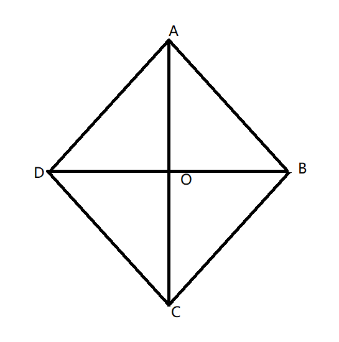
The perimeter of a rhombus is 100 cm. One of its diagonal is 30 cm. Find the length of the other diagonal and the area of the rhombus.
Answer
589.8k+ views
Hint: We will first find the length of each side of rhombus from the given perimeter of the rhombus. Use the property of rhombus and given diagonal to find the other diagonal of the rhombus. Hence, calculate the area of the rhombus.
Complete step-by-step answer:
The perimeter of the rhombus is 100 cm.
It is known that all sides of rhombus are equal.
Let the length of side of rhombus be $x$,
Then perimeter of rhombus is $4x$
Thus, $
4x = 100 \\
x = 25 \\
$
Hence, the length of each side of the rhombus is 25 cm.
We are given that the length of one of its diagonal is 30 cm.

In a rhombus, diagonals are perpendicular bisectors
Let diagonals bisect at $O$.
Let $AC$ be 30 cm., then the length of \[AO\] is $\dfrac{{30}}{2} = 15$cm
Also, triangle $\Delta AOB$ is a right triangle.
Apply Pythagoras theorem in $\Delta AOB$
$A{B^2} = A{O^2} + O{B^2}$
We have $AB = 25cm$ and $AO = 15cm$,
Therefore,
$
{\left( {25} \right)^2} = {\left( {15} \right)^2} + O{B^2} \\
O{B^2} = {\left( {25} \right)^2} - {\left( {15} \right)^2} \\
$
Simplifying the expression using the formula ${a^2} - {b^2} = \left( {a + b} \right)\left( {a - b} \right)$
$
O{B^2} = {\left( {25} \right)^2} - {\left( {15} \right)^2} \\
O{B^2} = \left( {25 + 15} \right)\left( {25 - 15} \right) \\
O{B^2} = 40\left( {10} \right) \\
O{B^2} = 400 \\
OB = 20 \\
$
Hence, the length of the other diagonal will be twice the length $OB$, which is 40units.
Next, we will find the area of the rhombus whose formula is $\dfrac{{{d_1} \times {d_2}}}{2}$, where ${d_1}$ and ${d_2}$ are the length of diagonals.
Thus, area of rhombus is,
$\dfrac{{40 \times 30}}{2} = \dfrac{{1200}}{2} = 600c{m^2}$
Note: One must be familiar with the properties of rhombus. Also, in this question, we have used Pythagoras theorem, so one must know how to apply Pythagoras theorem in any right triangle.
Complete step-by-step answer:
The perimeter of the rhombus is 100 cm.
It is known that all sides of rhombus are equal.
Let the length of side of rhombus be $x$,
Then perimeter of rhombus is $4x$
Thus, $
4x = 100 \\
x = 25 \\
$
Hence, the length of each side of the rhombus is 25 cm.
We are given that the length of one of its diagonal is 30 cm.

In a rhombus, diagonals are perpendicular bisectors
Let diagonals bisect at $O$.
Let $AC$ be 30 cm., then the length of \[AO\] is $\dfrac{{30}}{2} = 15$cm
Also, triangle $\Delta AOB$ is a right triangle.
Apply Pythagoras theorem in $\Delta AOB$
$A{B^2} = A{O^2} + O{B^2}$
We have $AB = 25cm$ and $AO = 15cm$,
Therefore,
$
{\left( {25} \right)^2} = {\left( {15} \right)^2} + O{B^2} \\
O{B^2} = {\left( {25} \right)^2} - {\left( {15} \right)^2} \\
$
Simplifying the expression using the formula ${a^2} - {b^2} = \left( {a + b} \right)\left( {a - b} \right)$
$
O{B^2} = {\left( {25} \right)^2} - {\left( {15} \right)^2} \\
O{B^2} = \left( {25 + 15} \right)\left( {25 - 15} \right) \\
O{B^2} = 40\left( {10} \right) \\
O{B^2} = 400 \\
OB = 20 \\
$
Hence, the length of the other diagonal will be twice the length $OB$, which is 40units.
Next, we will find the area of the rhombus whose formula is $\dfrac{{{d_1} \times {d_2}}}{2}$, where ${d_1}$ and ${d_2}$ are the length of diagonals.
Thus, area of rhombus is,
$\dfrac{{40 \times 30}}{2} = \dfrac{{1200}}{2} = 600c{m^2}$
Note: One must be familiar with the properties of rhombus. Also, in this question, we have used Pythagoras theorem, so one must know how to apply Pythagoras theorem in any right triangle.
Recently Updated Pages
The number of solutions in x in 02pi for which sqrt class 12 maths CBSE

Write any two methods of preparation of phenol Give class 12 chemistry CBSE

Differentiate between action potential and resting class 12 biology CBSE

Two plane mirrors arranged at right angles to each class 12 physics CBSE

Which of the following molecules is are chiral A I class 12 chemistry CBSE

Name different types of neurons and give one function class 12 biology CBSE

Trending doubts
What is BLO What is the full form of BLO class 8 social science CBSE

What are the 12 elements of nature class 8 chemistry CBSE

Full form of STD, ISD and PCO

What are gulf countries and why they are called Gulf class 8 social science CBSE

Citizens of India can vote at the age of A 18 years class 8 social science CBSE

What is the difference between rai and mustard see class 8 biology CBSE




